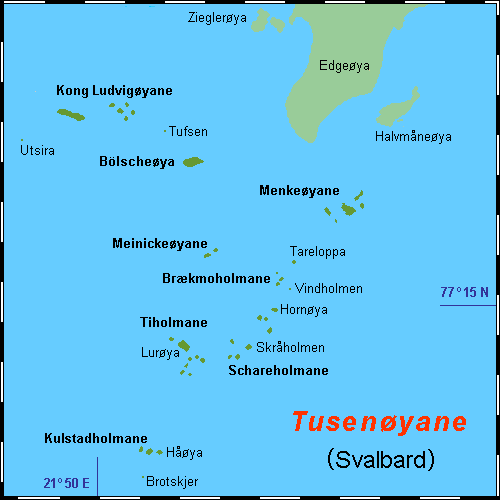|
Schareholmane
Schareholmane ( en, Schare Islands or ''Schare Islets'') is a group of three larger and a few smaller islets east of Tiholmane, part of Thousand Islands, an archipelago south of Edgeøya Edgeøya (), occasionally anglicised as Edge Island, is a Norwegian island located in southeast of the Svalbard archipelago; with an area of , it is the third-largest island in this archipelago. An Arctic island, it forms part of the Søraust-Sva .... The group includes Blokkøya, Kvalbeinøya and Havmerra. The islets are named after Christian Schare, who, along with four others, was forced to overwinter here after they had lost their ship on September 3, 1833. All but one (who had died) were saved on June 22, 1834. References * Norwegian Polar InstitutPlace Names of Svalbard Database Islands of Svalbard {{svalbard-geo-stub ... [...More Info...] [...Related Items...] OR: [Wikipedia] [Google] [Baidu] |
Thousand Islands (Svalbard)
Thousand IslandsDodd, G. J., G. P. Benson, & D. T. Watts. 1996. ''Arctic Pilot'', vol. 2. Taunton, UK: Hydrographer of the Navy, p. 225. ( no, Tusenøyane) is a group of small islands south of Edgeøya. They form part of the Svalbard archipelago. The group consists of over forty islands and islets, including Brotskjer, Kulstadholmane, Utsira, Tufsen, Kong Ludvigøyane, Bölscheøya, Hornøya, Tiholmane, Meinickeøyane, Sletteøya, Schareholmane, Skråholmen, Brækmoholmane, Tareloppa, Vindholmen, and Menkeøyane. History The Dutchman Joris Carolus was the first to distinctly mark a group of small islands south of Edgeøya. The Muscovy Company's map (1625) showed a vague mass of islands as well, some labeled, such as ''Wester I.'', ''Beare Iland'', ''Heling I.'', and the ''Hopeless Iles.'' (perhaps Kong Ludvigøyane). The cartographers Gerard Valck and Peter Schenk the Elder were the first to place a "great vague mass of islands stretching round the coast" south of ... [...More Info...] [...Related Items...] OR: [Wikipedia] [Google] [Baidu] |
Havmerra
Havmerra ( en, The Sea Horse) is an island in the eastern part of Schareholmane, part of Thousand Islands, an archipelago south of Edgeøya. ''Sea horse'' is an old name for the Walrus. The island harbors the most important population of this species in the southeastern region of Svalbard Svalbard ( , ), also known as Spitsbergen, or Spitzbergen, is a Norwegian archipelago in the Arctic Ocean. North of mainland Europe, it is about midway between the northern coast of Norway and the North Pole. The islands of the group range .... References Islands of Svalbard {{svalbard-geo-stub ... [...More Info...] [...Related Items...] OR: [Wikipedia] [Google] [Baidu] |
Tiholmane
Tiholmane ( en, "Ten Islands" or "Ten Islets") is a group of ten small islands that form part of Thousand Islands, an archipelago south of Edgeøya in Svalbard. The largest of the islands are Lurøya, Kalvøya, Langåra Langåra is one of the islands comprising Tiholmane, part of Thousand Islands, an island group south of Edgeøya. It is named after an island in Oslofjorden, Norway Norway, officially the Kingdom of Norway, is a Nordic country in Northe ... and Rugla. The group also includes the smaller Sperra, Spunset, Bommen, Proppen, Rullesteinøya and Røysholmen. References * Norwegian Polar InstitutPlace Names of Svalbard Database Islands of Svalbard {{svalbard-geo-stub ... [...More Info...] [...Related Items...] OR: [Wikipedia] [Google] [Baidu] |
Edgeøya
Edgeøya (), occasionally anglicised as Edge Island, is a Norwegian island located in southeast of the Svalbard archipelago; with an area of , it is the third-largest island in this archipelago. An Arctic island, it forms part of the Søraust-Svalbard Nature Reserve, home to polar bears and reindeer. An ice field covers its eastern side. The island takes its name from Thomas Edge (died 1624), an English merchant and whaler. It is seldom visited today and development of tourist facilities is forbidden by law because of its nature reserve status. History The history of Edgeøya's discovery has been a matter of dispute. Thomas Edge, writing in 1622, claimed the island was discovered by one of his ships in 1616. However, Joris Carolus, in a map published in 1614 and allegedly based on discoveries made by him the same year, shows what appears to be Edgeøya's south coast. Carolus showed the coastline split into two parts: "Onbekende Cust" (meaning "Unknown Coast" in Dutch) in the wes ... [...More Info...] [...Related Items...] OR: [Wikipedia] [Google] [Baidu] |
Blokkøya
Blokkøya ( en, Block Island) is an island in the southwestern part of Scareholmane, an island group in Thousand Islands, an archipelago south of Edgeøya Edgeøya (), occasionally anglicised as Edge Island, is a Norwegian island located in southeast of the Svalbard archipelago; with an area of , it is the third-largest island in this archipelago. An Arctic island, it forms part of the Søraust-Sva .... References * Norwegian Polar InstitutPlace Names of Svalbard Database Islands of Svalbard {{svalbard-geo-stub ... [...More Info...] [...Related Items...] OR: [Wikipedia] [Google] [Baidu] |
Kvalbeinøya
Kvalbeinøya ( en, Whale Bone Island) is the northwesternmost island in Scareholmane, part of Thousand Islands, an archipelago south of Edgeøya Edgeøya (), occasionally anglicised as Edge Island, is a Norwegian island located in southeast of the Svalbard archipelago; with an area of , it is the third-largest island in this archipelago. An Arctic island, it forms part of the Søraust-Sva .... The island derives its name from the fact that plains on the western side of the island (and part of the northern side) are covered with whale bones. References *Norwegian Polar InstitutPlace Names of Svalbard Database Islands of Svalbard {{svalbard-geo-stub ... [...More Info...] [...Related Items...] OR: [Wikipedia] [Google] [Baidu] |

